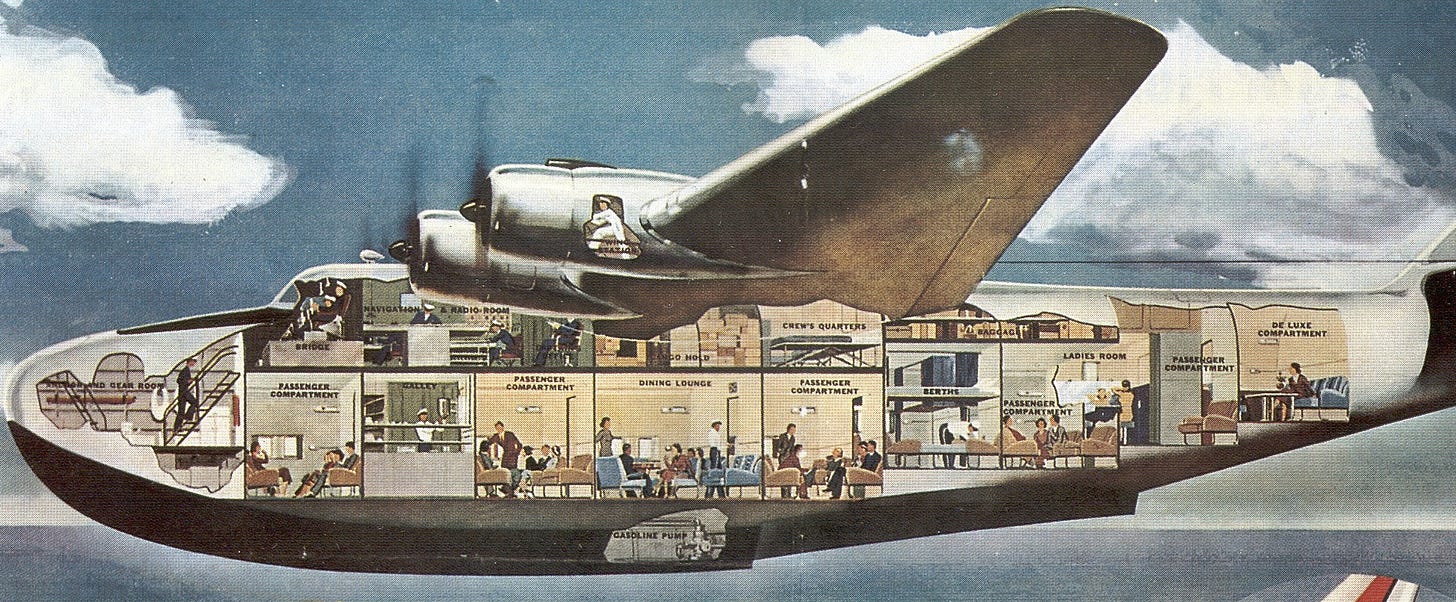The Irish Coffee - One night upon a darkened sea
The Story of the Irish Coffee
The streamlined flying boat, now painted military camouflage over its Pan Am livery, hurtles over the Atlantic under dark, ominous skies. The once-calm sea below begins to churn, with waves growing increasingly turbulent. As night approaches the distant flashes of lightning accompanied by the distant rumble of thunder indicate the severity of the impending storm.
The pilot asks the crew to inform the passengers that they will be turning back. He banks and turns, bringing the elegant Boeing 314 Clipper back on a course for Foynes, Ireland which they had left 5 hours earlier.
It was 1943, World War 2 was raging. The US had entered the war and with the success in Italy, the transatlantic planning for D-Day had started. The shortest route across the Atlantic is from Foynes to Botwood Newfoundland and that was the destination that fateful October day.
The crew broke the news to the passengers, an interesting mix of military, diplomats, journalists, and celebrities. Battered by the storm on their return journey, the weary travelers sought solace in the Clipper's comforts: some nestled into the sleeping cots for a rest, others dined, savoring the reprieve, while the click and shuffle of playing cards accompanied conversations in the lounge.
Upon receiving the Morse code message about the flight's return, Brendan O'Regan, the airport's Comptroller, mobilized his staff for the arrival. There was luggage crew to unload, and restaurant staff to give them a welcome after their frustrating journey. Brendan was from Clare, a local man who would go on to be a legend in local and international business, he created the world's first duty-free store at Shannon airport.
Brendan prided himself on hospitality, and to extend an Irish welcome to the guests who would be returning, he asked Chef Joe Sheridan to make something to warm them up. Joe from Northern Ireland had been hired to run the restaurant based on his blunt confident one-line application for the job "Dear Sir, I’m the man for the job. Yours sincerely, Joe Sheridan".
Joe enhanced the coffee with a touch of Irish Whiskey, providing warmth to the cold, weary travelers facing another night away from home. The warm mugs and the smell of the steaming coffee helped to take the sting out of their disappointment and the whiskey didn't hurt either. One of the passengers thanked Joe for the coffee and asked him if this was Brazilian coffee. "No, it was Irish coffee," said Joe with a grin on his face. Sheridan would soon afterward show off his new beverage in a stemmed glass crowned with cream. The iconic drink was born.
The drink was served to passengers at Foynes and later, when the days of the flying boat were gone, at Shannon airport as a ‘welcome’ beverage. In 1951, American travel writer Stan Delaplane was traveling through Shannon airport and enjoyed his Irish Coffee so much that when he returned to San Francisco, he told his friend, Buena Vista café owner Jack Koeppler, about the drink.
To have the perfect Irish Coffee, Koeppler offered Sheridan a position at Buena Vista café. Again, Joe was indeed the man for the job. Joe was to spend the rest of his life in the United States. The Buena Vista Café is today the American home of the Irish Coffee. Irish coffee rapidly gained popularity at the Buena Vista Cafe, quickly spreading to bars and restaurants nationwide.
Today, Irish coffee is enjoyed all over the world and has become a classic cocktail in its own right.Here’s the traditional Irish coffee recipe, with the secret of the cream.
Use a stemmed Coffee Glass for best results :
Step One: Preheat your coffee glass by filling it with hot water for 5 seconds, then pour the water out (put a metal spoon in before you pour to ensure the glass doesn’t shatter from the heat).
Step Two: Add 1 teaspoon of brown sugar ( always add the sugar even if you don't normally take sugar. The cream won't float on top without the sugar) and a good measure of Irish whiskey into the warmed glass.
Step Three: Fill the glass to close to the brim ( leaving room for cream) with hot, strong black coffee. Stir well to dissolve all the brown sugar.
Step Four: Carefully pour lightly whipped cream over the back of a spoon so that it floats on top of the coffee. The cream expands, so slowly does it.
Step Five: Do not stir after adding the cream; the optimal flavor comes from drinking the coffee and Irish whiskey through the cream.
Further reading:
The S42




Frankie and I went to the Buena Vista Cafe on our first trip together to San Francisco! 🙂
Foynes is home to a flying boat museum which I was lucky enough to visit some years back. It houses a Pan Am Clipper fuselage and pieces of other flying boats. Fascinating to find out this is the home of Irish Coffee.